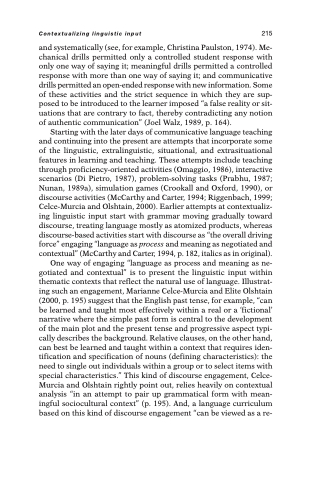Page 227 - Beyond Methods
P. 227
Contextualizing linguistic input 215
and systematically (see, for example, Christina Paulston, 1974). Me- chanical drills permitted only a controlled student response with only one way of saying it; meaningful drills permitted a controlled response with more than one way of saying it; and communicative drills permitted an open-ended response with new information. Some of these activities and the strict sequence in which they are sup- posed to be introduced to the learner imposed “a false reality or sit- uations that are contrary to fact, thereby contradicting any notion of authentic communication” (Joel Walz, 1989, p. 164).
Starting with the later days of communicative language teaching and continuing into the present are attempts that incorporate some of the linguistic, extralinguistic, situational, and extrasituational features in learning and teaching. These attempts include teaching through proficiency-oriented activities (Omaggio, 1986), interactive scenarios (Di Pietro, 1987), problem-solving tasks (Prabhu, 1987; Nunan, 1989a), simulation games (Crookall and Oxford, 1990), or discourse activities (McCarthy and Carter, 1994; Riggenbach, 1999; Celce-Murcia and Olshtain, 2000). Earlier attempts at contextualiz- ing linguistic input start with grammar moving gradually toward discourse, treating language mostly as atomized products, whereas discourse-based activities start with discourse as “the overall driving force” engaging “language as process and meaning as negotiated and contextual” (McCarthy and Carter, 1994, p. 182, italics as in original).
One way of engaging “language as process and meaning as ne- gotiated and contextual” is to present the linguistic input within thematic contexts that reflect the natural use of language. Illustrat- ing such an engagement, Marianne Celce-Murcia and Elite Olshtain (2000, p. 195) suggest that the English past tense, for example, “can be learned and taught most effectively within a real or a ‘fictional’ narrative where the simple past form is central to the development of the main plot and the present tense and progressive aspect typi- cally describes the background. Relative clauses, on the other hand, can best be learned and taught within a context that requires iden- tification and specification of nouns (defining characteristics): the need to single out individuals within a group or to select items with special characteristics.” This kind of discourse engagement, Celce- Murcia and Olshtain rightly point out, relies heavily on contextual analysis “in an attempt to pair up grammatical form with mean- ingful sociocultural context” (p. 195). And, a language curriculum based on this kind of discourse engagement “can be viewed as a re-


